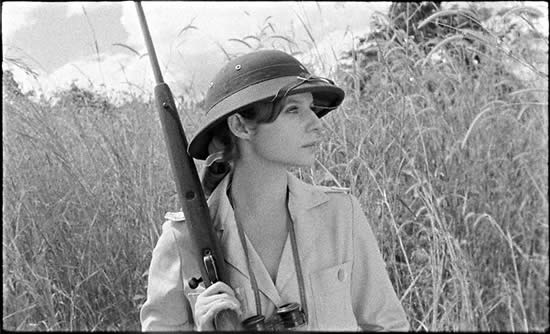 TABU, which at first appears to be a tedious exploration of unlikeable characters, turns out to be simply gorgeous. Part I, “A Paradise Lost” takes place in Lisbon. It follows three women—the aforementioned “unlikeable” characters. Pilar (Teresa Madruga) is a devout Catholic, a defender of social justice, a movie lover, and a bit of an enabler. She is especially concerned for her neighbor, Aurora (Laura Soveral). Aurora is in her eighties. She is eccentric, entitled, addicted to gambling, and rather paranoid—convinced that her maid and caretaker, Santa (Isabel Cardoso) is cursing her with voodoo. Santa, a stoic Cape-Verdean, minds her business, follows orders from Aurora’s estranged daughter, and attends adult literacy classes at night, working her way through Robinson Crusoe.
TABU, which at first appears to be a tedious exploration of unlikeable characters, turns out to be simply gorgeous. Part I, “A Paradise Lost” takes place in Lisbon. It follows three women—the aforementioned “unlikeable” characters. Pilar (Teresa Madruga) is a devout Catholic, a defender of social justice, a movie lover, and a bit of an enabler. She is especially concerned for her neighbor, Aurora (Laura Soveral). Aurora is in her eighties. She is eccentric, entitled, addicted to gambling, and rather paranoid—convinced that her maid and caretaker, Santa (Isabel Cardoso) is cursing her with voodoo. Santa, a stoic Cape-Verdean, minds her business, follows orders from Aurora’s estranged daughter, and attends adult literacy classes at night, working her way through Robinson Crusoe.
Part I is the “lost” part of “ A Paradise Lost,” and its slow, surreal, melancholic atmosphere is a bit hard to take. But it’s also hard to turn away from. The exquisite cinematography (shot by Rui Pocas in 35mm black and white film), as well as the locations, interiors, wardrobes, and sets give TABU the sensual quality that is the trademark of good cinema. And while it initially lacks the typical conflicts and magnetism we expect from movies, the bizarre exploits of these unique women are compelling enough to captivate an audience up until the major turning point. When Aurora becomes fatally ill, her last request is for Pilar to find a man named Gian Luca Ventura (Henrique Esplrito). It turns out that Ventura has a fascinating story to tell about Aurora’s past.
Part II is the “paradise” part of “A Paradise Lost.” It takes place in colonial Africa circa 1960. And this is where things really warm up. Unlike Part I, it is a recognizable kind of story, a love story involving a beautiful young Aurora (Ana Moreira) and a dashing young Ventura (Carloto Cardoso). It is an exotic romance—a story in the vein of Isabelle Allende or Gabriel Garcia Marquez. Shot in 16mm black and white film, it is lush and warm and classic.
Although Portuguese director Miguel Gomes said he is most inspired by American classics, TABU is also reminiscent of works by Federico Fellini, Ingmar Bergman, and Jean Renoir. Gomes’s work is so steeped in the aesthetic of great early 20th century cinema that it’s almost indistinguishable from its predecessors. Rock and Roll songs from the late 50s add a flavor of Americana that both compliments and contrasts TABU’s exoticism nicely. In Part II, Gomes also pays homage to silent film, though in an unusual way. There is no audible dialogue, but the ambient sounds are there, and the story is guided by beautifully written narration (as told by Ventura) and voice overs of letters exchanged between Aurora and Ventura.
Gomes and co-writer Mariana Ricardo give us a story that is rich with history—a sense of time and place that takes the viewer out of his or her current context. It’s a strange story, but one that could have actually happened. Along with the adventure and romance are the darker elements of colonialism, racism, the excesses of a ruling class, and the damning nature of moralism. Visually, there is a lot of play with shadow and light. The same is true of the narrative. Loss and Paradise are intertwined. But, for all its art, its cinefilia, its political and existential insinuations, TABU, more than anything, is a pleasure.
TABU opens this Friday, January 25th at Laemmle’s Royal in West L.A. and Laemmle’s Playhouse 7 in Pasadena
Running Time: 118 minutes
Language: Portuguese with English subtitles
www.adoptfilms.com

